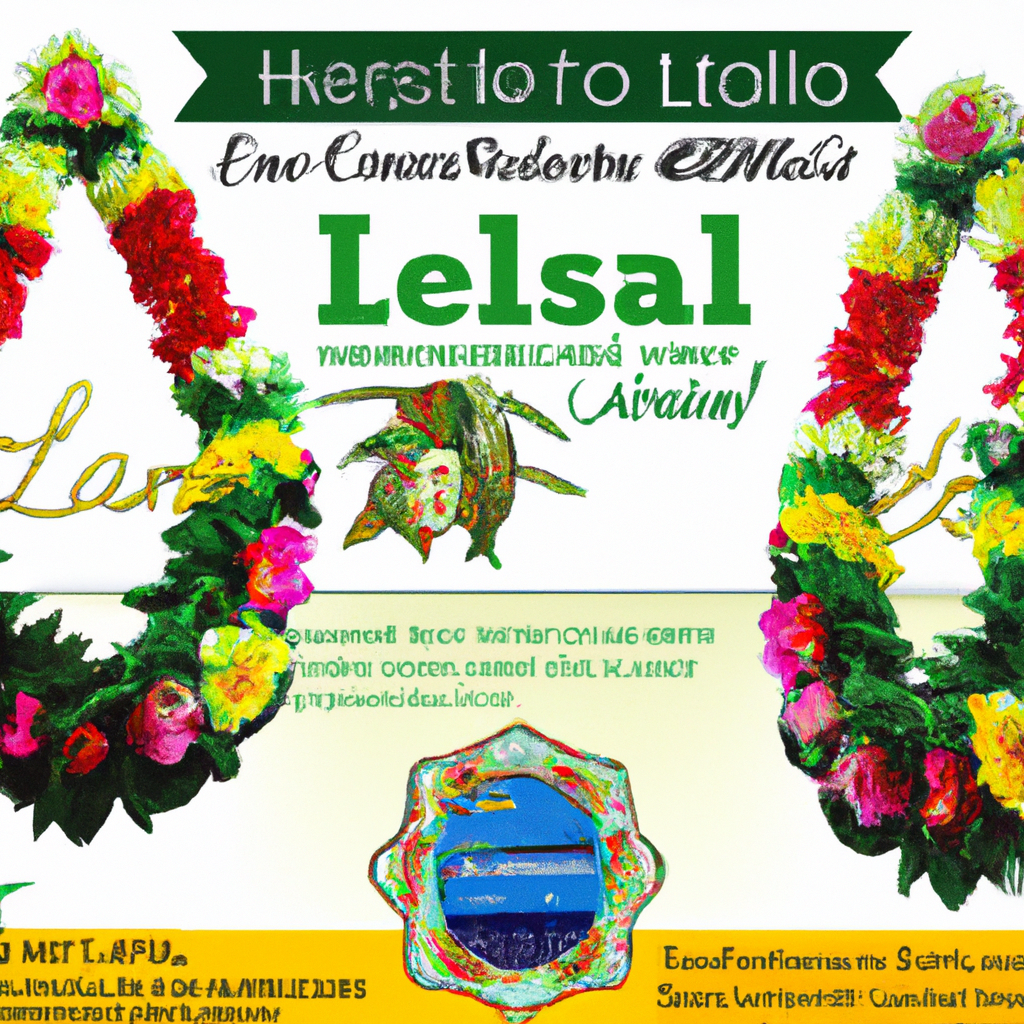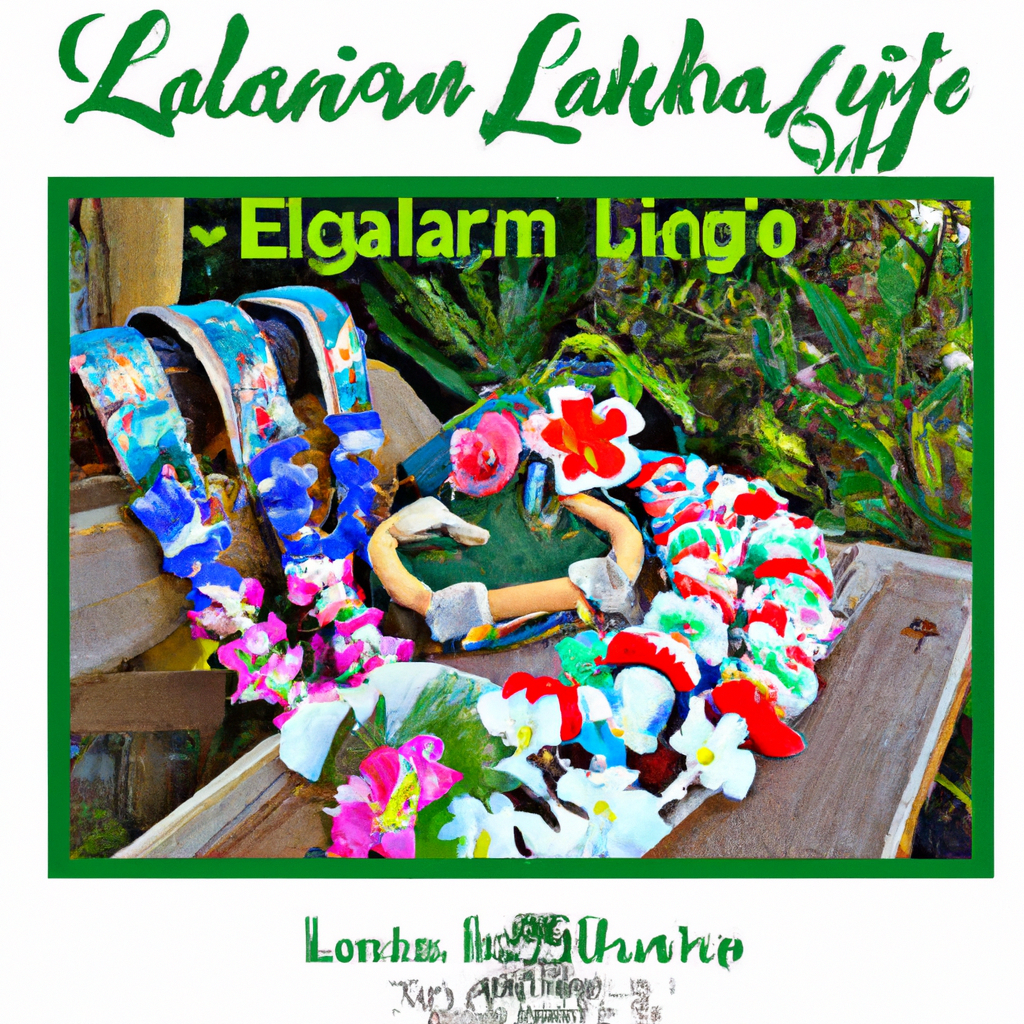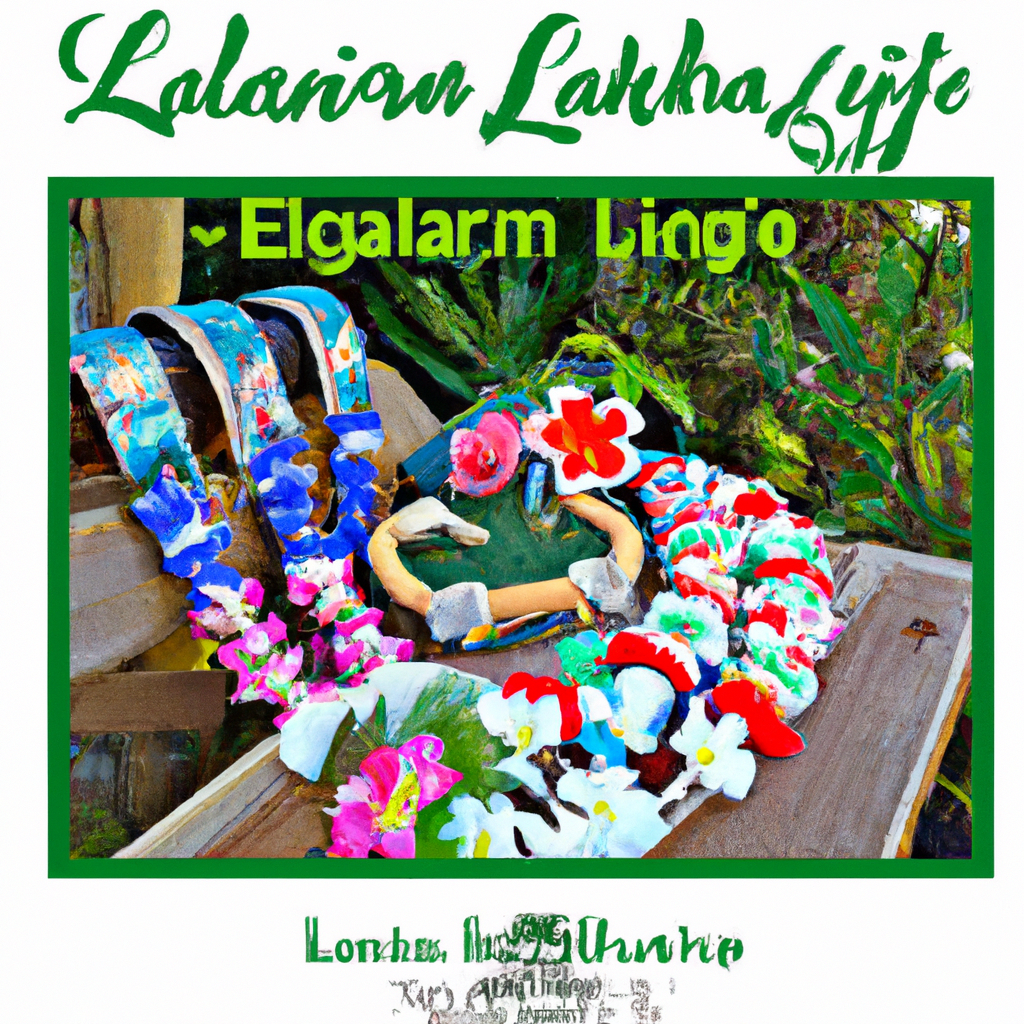Imagine yourself strolling along the sandy shores of Hawaii, the warm sun kissing your skin and the soothing sound of waves serenading your ears. As you immerse yourself in the enchanting beauty of the islands, you will undoubtedly encounter the vibrant symbol of Hawaiian culture – the lei. This captivating article explores the deep-rooted significance of lei in Hawaiian celebrations, shedding light on its historical and cultural importance. From its role in traditional ceremonies to its meaning in daily life, discover how the lei continues to weave a sense of unity, love, and aloha throughout the Hawaiian islands.
History of Lei
Origins of Lei
Lei, a beautiful and cherished symbol of Hawaiian culture, has a rich and fascinating history dating back centuries. The origins of lei can be traced to the Polynesians who settled in the Hawaiian islands thousands of years ago. These early settlers, with their deep connection to nature, celebrated and honored the abundance and beauty of their surroundings by adorning themselves with garlands made from leaves, vines, shells, and flowers. This practice of wearing lei, known as “haku lei,” was an integral part of everyday life and signified a sense of belonging and connection to the land.
Evolution of Lei
Over time, the art of lei-making evolved as different influences and traditions merged with the Hawaiian culture. With the arrival of explorers and missionaries in the 18th and 19th centuries, lei-making underwent further transformation. New plants and materials were introduced, expanding the range of flowers and leaves used in lei-making. Intricate techniques were developed, such as the intricate braiding and weaving known as “hilo,” and the delicate craft of stringing flowers together to create beautiful, fragrant lei.
Different Types of Lei
Lei come in a variety of forms, each with its own unique significance and style. The most commonly known type of lei is the “haku lei,” which is made by weaving and braiding a combination of flowers, leaves, and sometimes feathers. Another popular type of lei is the “kukui nut lei,” made from the shiny nuts of the kukui tree, which symbolizes enlightenment and protection. Other lei styles include the “ti leaf lei,” made from the leaves of the ti plant, and the “maile lei,” made from the fragrant and prized maile vine. Each type of lei carries its own symbolism and holds a special place in Hawaiian culture.
Symbolism of Lei
Representation of Love and Aloha
One of the key symbolic meanings of lei is its representation of love and aloha, the Hawaiian concept of compassion, love, and respect for others. Lei are often given as a token of affection, friendship, or celebration, and are commonly exchanged during special occasions such as weddings, birthdays, and graduations. The act of giving and receiving a lei is a heartfelt gesture, symbolizing a connection and bond between individuals. It is a tangible expression of love and aloha, carrying with it the warmth and spirit of the giver.
Connection to Nature
Lei also hold a deep connection to nature, reflecting the profound relationship between the Hawaiian people and their environment. The flowers, leaves, and materials used in lei-making are gathered from the land and represent the abundance and beauty of the natural world. The act of making lei is a way of honoring and respecting nature, acknowledging its role in sustaining and nurturing life. Wearing lei not only enhances one’s physical appearance but also serves as a reminder of the interconnectedness and harmony between humans and the natural world.
Significance of Colors and Materials
The colors and materials used in lei are carefully chosen and hold their own significance. Different flowers and leaves are associated with varying meanings and intentions. For example, red flowers evoke love and passion, while yellow ones are often used to symbolize friendship and happiness. Additionally, the materials used in lei-making, such as shells, feathers, and even bones, can carry cultural and spiritual significance. Each lei crafted with intention and thoughtfulness, combining specific colors and materials, tells a story and conveys a deeper meaning.

Traditional Lei-Making
Materials Used
Traditional lei-making involves the use of a wide range of materials, sourced directly from nature. Flowers, leaves, vines, feathers, shells, and nuts are among the most commonly used elements in creating lei. Native flowers like hibiscus, plumeria, and pikake are often chosen for their vibrant colors and fragrant scents. The leaves of the ti plant, ferns, and maile vine are also popular choices, adding texture and variety to the lei. These natural materials are carefully gathered and prepared, ensuring their freshness and longevity.
Techniques and Process
The process of making lei is a true labor of love and requires skill, patience, and creativity. Lei-makers, known as “lei po’o” or “kūpuna lei,” pass down their knowledge and techniques from generation to generation, preserving the traditional art form. Various techniques are employed, including haku (braiding and weaving), stringing, and sewing. The delicate flowers and leaves are carefully threaded onto a base, such as a strand of fiber or string, using a variety of patterns and arrangements to create visually stunning lei.
Role of the Mālama ‘Āina
Central to the traditional lei-making process is the concept of “Mālama ‘Āina,” which translates to “care for the land.” Lei-makers have a deep respect and understanding of the environment, ensuring sustainable harvesting practices and preserving the natural beauty of the plants and flowers they use. They gather materials mindfully, taking only what is needed and leaving behind enough to regenerate and thrive. The practice of Mālama ‘Āina reinforces the connection between lei-making, culture, and the land, highlighting the importance of preserving both.
Lei Protocols and Etiquette
Gifting and Receiving Lei
Gifting and receiving a lei is a cherished act that follows certain protocols and etiquette in Hawaiian culture. When giving someone a lei, it is customary to offer it with a warm smile and a gentle touch, placing it around their neck while making eye contact. This gesture symbolizes the transfer of love, affection, and respect. It is important to never remove a lei oneself; instead, it should be removed by the person who gifted it, as a sign of honor and recognition. When receiving a lei, it is customary to accept it with gratitude, acknowledging the thoughtfulness and love behind the gesture.
Proper Way to Wear Lei
Wearing a lei is considered a privilege and carries its own set of guidelines. The lei should be worn with respect, keeping it slightly above the collarbone and centered around the neck. It is often said that the open end of the lei should be facing towards the giver, symbolizing the flow of love and connection between the two individuals. It is customary to wear the lei for as long as it remains fresh and vibrant, allowing its beauty and fragrance to be appreciated.
Lei for Different Occasions
Lei are an integral part of many Hawaiian celebrations and events. They are used to mark significant occasions such as weddings, birthdays, graduations, and even funerals. For weddings, the bride and groom often exchange lei as a symbol of their love and commitment. Birthdays are celebrated with lei in vibrant colors that reflect the joy and happiness of the day. Graduations are adorned with lei to honor the achievements of the graduates, symbolizing their transition into a new phase of life. Lei are also presented during funerals as a way of expressing condolences and bidding farewell to the departed.

Lei in Hawaiian Celebrations
Weddings
In Hawaiian weddings, lei play a significant role in the ceremony and symbolize the bond between the couple. The exchange of lei between the bride and groom is a heartfelt gesture of love and commitment. The bride and groom typically present each other with lei made from fragrant flowers such as maile, pikake, or plumeria. Family members and guests may also participate by gifting lei to the couple, adding to the abundance of flowers and love on this special day.
Birthdays
Birthdays in Hawaii are vibrant and joyful celebrations, often marked by the giving and receiving of lei. Friends and family gather to honor the birthday celebrant, adorning them with colorful lei that represent love, happiness, and good fortune. The lei chosen for birthdays are often vibrant and energetic, reflecting the festive spirit of the occasion. It is a beautiful way of showing love and appreciation for the person who is being celebrated.
Luau
The traditional Hawaiian feast, known as a luau, is a gathering filled with food, music, and dance. Lei are an integral part of this celebration, serving as a symbol of hospitality and warmth. Guests are often greeted with lei, welcoming them into the gathering and creating an atmosphere of camaraderie. The vibrant colors and sweet fragrance of the lei enhance the festive ambiance and add a touch of beauty to the occasion.
Graduation
Graduating from school is a momentous milestone, and lei are a cherished symbol of celebration and achievement. Family and friends present graduates with lei made from their favorite flowers or school colors. The act of receiving lei during graduation serves as a recognition of the hard work and dedication that led to this accomplishment. Wearing the lei during the ceremony is a source of pride and honor, signifying the support and love surrounding the graduate.
Lei as a Symbol of Identity
Lei as a Cultural Identity
Lei hold great significance in Hawaiian culture and serve as a powerful symbol of identity. They are regarded as an expression of one’s connection to the land and heritage, emphasizing the importance of cultural roots and traditions. Wearing or creating lei is an act of pride and affirmation, highlighting one’s unique cultural identity as a Hawaiian or someone who appreciates and respects Hawaiian culture. Lei are an essential element in cultural practices and ceremonies, reinforcing the bond and sense of belonging within the Hawaiian community.
Lei as a Sense of Belonging
Lei also foster a sense of belonging and community. They are a visual representation of the connections and relationships that individuals have with one another, their culture, and the environment. The act of giving and receiving lei creates a sense of unity and inclusivity, strengthening the bonds between family, friends, and the wider community. Lei symbolize the interconnectedness of people, reminding us of the importance of compassion, kindness, and aloha in our interactions with others.
Lei in Art and Literature
Lei in Traditional Hawaiian Art
Lei have been a source of inspiration for Hawaiian artists for centuries. In traditional Hawaiian art, lei are often depicted in vibrant and intricate detail, showcasing their beauty and cultural significance. Paintings, carvings, and sculptures feature lei as a central motif, celebrating their role as a symbol of love, connection, and spirituality. These art forms pay homage to the intricate craftsmanship and the significance of lei in Hawaiian culture, preserving their beauty for generations to come.
Lei in Contemporary Art
Contemporary Hawaiian artists continue to incorporate lei in their artwork, infusing traditional techniques with modern mediums and ideas. Lei have become a powerful tool for self-expression and storytelling. Artists experiment with new materials, colors, and patterns while staying true to the essence of lei-making. Lei-themed installations, mixed media pieces, and performances showcase the diverse and evolving interpretation of this cherished symbol, keeping the spirit of lei alive in the art world.
Lei in Hawaiian Literature
Hawaiian literature often celebrates the beauty and significance of lei. Poets and writers have captured the essence of lei-making in their verses, using vivid descriptions to evoke the emotions and symbolism associated with this treasured art form. Stories, songs, and chants honor the history and cultural importance of lei, exploring themes of love, nature, and identity. Through literature, the spirit of lei is preserved and shared with audiences both within Hawaii and around the world.
Commercialization and Mass Production of Lei
Impact on Traditional Lei-Making
In recent years, there has been a rise in the commercialization and mass production of lei, which has had both positive and negative impacts on traditional lei-making. On one hand, the increased demand for lei has created economic opportunities for lei-makers and their families, allowing them to share their cultural heritage while providing for their livelihood. However, this mass production has also led to a loss of authenticity and craftsmanship, with lei being manufactured hastily and without the same level of care and artistry as traditional lei.
Challenges for Authenticity
The commercialization of lei has posed challenges for maintaining the authenticity and integrity of this cultural practice. The use of artificial flowers and non-traditional materials, such as plastic, has become more common, diluting the essence and symbolism of lei-making. Additionally, the pressure to meet high volume demands can lead to shortcuts in the process, compromising the quality and cultural significance of lei. This raises concerns about preserving the traditional art form and ensuring its continued recognition and respect.
Preservation and Revival of Lei Culture
Efforts by Cultural Organizations
Various cultural organizations and groups have emerged to preserve and revive the art of lei-making. These organizations work tirelessly to educate and raise awareness about the cultural significance and craftsmanship of lei. They provide platforms for skilled lei-makers to display their work, ensuring that their talents are recognized and respected. Through exhibitions, workshops, and community events, these organizations play a vital role in keeping the spirit of lei alive and supporting traditional lei-makers.
Role of Education and Awareness
Education and awareness are pivotal in preserving the art of lei-making and fostering a deeper understanding of its cultural significance. Schools and educational institutions in Hawaii have started incorporating lei-making into their curriculum, ensuring that younger generations learn and appreciate this cherished tradition. By teaching the history, techniques, and symbolism of lei, educators help to instill a sense of pride and cultural identity in future lei-makers and enthusiasts.
Lei-Making Workshops and Classes
Lei-making workshops and classes provide hands-on opportunities for individuals to learn the art of lei-making from skilled practitioners. These workshops offer both locals and visitors the chance to understand the intricate techniques, gather sustainable materials, and create their own lei. By actively participating and engaging in the process, individuals develop a deeper appreciation for the art form and can continue the legacy of lei-making, ensuring its continuation for generations to come.
Conclusion
Significance of Lei in Hawaiian Culture
Lei hold a profound significance in Hawaiian culture, serving as a beautiful symbol of love, connection, and respect. They embody the spirit of aloha and showcase the deep relationship between the people of Hawaii and their environment. Lei-making, with its rich history and cultural heritage, provides a tangible connection to the past and a source of pride for the present. The intricate craftsmanship, symbolism, and protocols associated with lei are testament to the importance of preserving and honoring this treasured art form.
Continued Relevance and Importance
In a rapidly changing world, lei continue to hold great relevance and importance. They remind us of the value of human connection, the beauty of nature, and the power of cultural heritage. Lei serve as a bridge between generations, fostering a sense of belonging and unity. As long as there are celebrations, expressions of love, and a desire to honor tradition, lei will remain a cherished symbol of Hawaiian culture, perpetuating the spirit of aloha for years to come.
